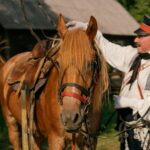The relationship between warriors and their steeds stands as one of the most enduring partnerships in military history. Among all horse breeds, none captured the imagination and loyalty of ancient warriors quite like the Arabian horse. These remarkable animals were far more than transportation or battle companions—they were strategic assets, revered for their speed, intelligence, and unmatched endurance. For millennia, from the sweeping deserts of the Middle East to the military campaigns of Europe, Arabian horses carried warriors into battle with a blend of grace and power that no other breed could equal. Their legendary reputation wasn’t born of romanticism alone—it was forged through battlefield performance, genetic excellence, and a deep bond with their riders that helped redefine the art of war across civilizations.
The Desert-Born Advantage

The unforgiving environment of the Arabian Peninsula shaped Arabian horses into exceptional war mounts through centuries of natural selection. Unlike breeds developed in more temperate regions, Arabians evolved to survive on minimal water and sparse forage, gaining extraordinary stamina that directly translated to battlefield endurance. Their natural heat tolerance allowed them to perform in scorching conditions that would overwhelm other horses. This desert heritage produced animals capable of carrying warriors for days across hostile terrain while maintaining energy and alertness. The environmental pressures of their homeland effectively pre-conditioned Arabian horses for the extreme demands of warfare, giving their riders a decisive advantage across a wide range of battlegrounds.
Superior Physical Attributes

Arabian horses possess a unique physical structure that ancient warriors quickly recognized as ideal for combat. Their distinctive concave facial profile allows for larger sinus cavities, enhancing oxygen intake and improving breathing efficiency during prolonged exertion. The breed’s compact build—featuring a short back and powerful hindquarters—provides exceptional agility, a crucial advantage amid the chaos of battle. Their naturally high tail carriage, while visually striking, also reflects a distinctive spinal anatomy that contributes to their maneuverability. Perhaps most significantly, Arabians typically have denser bone structure than other breeds of similar size, offering a rare combination of durability and refinement. This blend of speed, strength, and endurance made them invaluable assets on the battlefield.
Unmatched Endurance Capabilities

Warriors prized Arabian horses above all others for their legendary stamina, which far exceeded that of other ancient breeds. Historical accounts describe Arabians carrying fully armored riders across 100 miles of desert in a single day—a feat beyond the capacity of most horses. Their exceptional cardiovascular efficiency, shaped by both natural selection and selective breeding, gave them greater blood volume relative to body size and enhanced oxygen utilization. This, combined with a naturally efficient metabolism, allowed them to convert sparse forage into sustained energy—an invaluable trait during long campaigns with unreliable supply lines. Their unmatched endurance reshaped military strategy, making lightning raids and prolonged pursuits possible in ways that lesser mounts simply could not match.
Intelligence and Trainability

Beyond their physical traits, Arabian horses offered ancient warriors cognitive advantages that proved crucial on the battlefield. Their heightened intelligence enabled more sophisticated training and complex maneuvers, giving riders a distinct tactical edge. These horses displayed remarkable situational awareness, often sensing ambushes or threats before their human counterparts. Their ability to form deep bonds with riders created intuitive partnerships where subtle cues conveyed complex commands—an essential asset amid the chaos and noise of combat. Most importantly, Arabian horses exhibited extraordinary composure under pressure, remaining focused and responsive even in the most terrifying conditions, where other breeds might falter or panic.
Cultural Value and Status Symbol

Possessing an Arabian horse conveyed immense prestige and power in ancient societies, elevating a warrior’s status both on and off the battlefield. These prized animals were so valuable they served as diplomatic currency—exchanged by rulers to forge alliances or display wealth and influence. Ancient records show that stealing an Arabian war horse was often punishable by death, underscoring their strategic and cultural importance. The finest horses were worth more than their weight in gold, with some accounts describing individual mounts being traded for entire villages or vast territories. Beyond their military utility, Arabian horses became enduring symbols of nobility and martial excellence, with the quality of a warrior’s horse seen as a reflection of his rank, prowess, and honor.
Selective Breeding and Bloodline Preservation

Ancient warriors developed sophisticated breeding practices for Arabian horses long before the advent of modern genetics, relying on intuitive knowledge to preserve and enhance desirable traits. Bedouin tribes maintained meticulous oral records of bloodlines, often tracing superior horses through maternal lines with more precision than many societies applied to human genealogy. Breeding stock was subjected to rigorous endurance trials, ensuring that only the most resilient and battle-ready horses passed on their lineage. This purposeful selection produced animals with an ideal blend of speed, stamina, courage, and trainability. In many ways, these early breeding traditions represent one of the earliest forms of applied genetic refinement, with warriors acting as both scientists and beneficiaries of the extraordinary horses they cultivated.
Mobility and Tactical Advantages

Arabian horses revolutionized battlefield mobility, offering ancient warriors tactical advantages that slower, less agile breeds couldn’t provide. Their explosive acceleration enabled powerful charges, while their agility allowed for sophisticated maneuvers such as the feigned retreat—a tactic demanding absolute trust and seamless coordination between horse and rider. Mounted warriors could execute rapid flanking attacks or swift tactical withdrawals with a precision that heavier cavalry units couldn’t match. Their surefootedness in rough terrain further amplified their battlefield value, allowing operations where other horses might falter. These mobility advantages translated into real strategic dominance, with historical accounts detailing how Arabian-mounted forces often overcame larger armies through speed, agility, and surprise.
Historical Impact on Military Campaigns

The Arabian horse’s impact on military history spans continents and centuries, reshaping the nature of warfare wherever it was deployed. Alexander the Great’s successful campaign against Persia was aided by the integration of Arabian horses into his cavalry, granting his armies unmatched mobility across expansive terrain. During the Islamic conquests, Arabians enabled Muslim forces to traverse vast regions of North Africa and Europe, executing rapid, strategic advances that overwhelmed their enemies. Even the technologically superior European Crusaders were frequently outmaneuvered by the swift, agile Saracen cavalry mounted on Arabians—eventually prompting them to adopt the breed themselves. Centuries later, Napoleon recognized their enduring military value, founding breeding programs to infuse his cavalry with Arabian bloodlines. From antiquity through the early modern era, Arabian horses remained at the heart of military innovation and tactical supremacy.
Adaptability to Diverse Battle Environments

Unlike more specialized horse breeds, Arabian horses exhibited exceptional adaptability across vastly different combat environments, making them indispensable to warriors waging campaigns through varied terrain. Bred in harsh desert climates, they developed remarkable heat tolerance, yet also proved resilient in colder regions where other breeds often struggled. Arabian horses navigated rocky mountain paths with surefooted precision while maintaining their famed speed across open plains. Their efficient metabolism enabled them to remain in peak condition even on sparse or poor-quality forage during long campaigns. This environmental versatility allowed warriors to rely on a single mount across multiple climate zones and terrains—a logistical advantage that streamlined military planning and reduced the need for diverse cavalry units tailored to specific environments.
Partnership Bond with Warriors

The unique bond between Arabian horses and their warrior riders went beyond the typical human-animal relationship, forming partnerships that operated as unified combat units. Historical accounts tell of horses remaining loyally by fallen riders on battlefields, sometimes defending them against enemy attackers. The breed’s natural affinity for human connection allowed for remarkable communication, with subtle shifts in weight or pressure replacing more overt commands. This deep bond enabled complex battle maneuvers requiring perfect synchronization, such as mounted archery or spear-throwing at full gallop. Warriors often named their Arabian horses, composed poetry about them, and regarded them as battle companions rather than mere animals—a relationship celebrated in numerous ancient texts that honor these horses with the same reverence as human heroes.
Recovery and Rehabilitation Capabilities

Arabian horses possessed exceptional recovery abilities that kept warriors combat-ready even during prolonged campaigns with minimal rest. Their efficient metabolic systems enabled them to rebound from exertion faster than heavier warhorses, often requiring only a fraction of the downtime. Historical accounts describe Arabian horses cooling down rapidly after intense activity—an advantage rooted in their desert adaptations and effective heat dissipation. Their natural hardiness also meant they experienced fewer injuries under similar conditions, and when injuries did occur, they often healed more swiftly. This capacity for rapid recovery gave warriors a clear military edge, allowing them to remain mobile and combat-effective while opponents riding less resilient mounts were forced to rest or withdraw.
Legacy in Modern Horse Breeding

The qualities ancient warriors prized in Arabian horses continue to shape equine breeding worldwide, with their genetic influence reaching virtually every modern light horse breed. The Thoroughbred racing industry traces its roots to three Arabian stallions imported to England in the 17th and 18th centuries, whose descendants now dominate the sport. Military cavalry programs in the 18th and 19th centuries also introduced Arabian bloodlines to enhance endurance and intelligence in their mounts. Even today, competitive endurance riding—which tests horses over distances of up to 100 miles—is still dominated by Arabian horses and their close derivatives. The breed’s legacy extends beyond physical traits to include the temperament qualities ancient warriors valued: intelligence, trainability, and a deep bond with humans—all of which remain highly prized in modern equestrian disciplines.
In conclusion, the Arabian horse earned its revered status among ancient warriors through a rare combination of physical power, intelligence, and adaptability that reshaped the nature of warfare. These were not merely aesthetic preferences but strategic assets that directly contributed to battlefield success and survival. As living weapons, Arabian horses expanded a warrior’s capabilities in ways unmatched by any other breed, providing decisive advantages in countless ancient conflicts. Their legacy lives on—not just in modern horse breeding, but in our understanding of the profound bond possible between humans and animals. When ancient warriors spoke of their Arabian horses with near-mystical reverence, they weren’t indulging in poetic exaggeration—they were recognizing a military asset so vital that the fate of empires often depended on their possession of these extraordinary animals.







